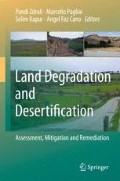Abstract
The highlands of south-western Uganda account for the bulk of field pea (Pisum sativum L.) produced and consumed in the country. The crop fetches a stable price, which is as high as that of beef, but it has remained outside the mainstream of the research process. Low soil fertility, unfortunately, is poised to eliminate the crop. Nitrogen, phosphorus and potassium have variously been reported as deficient on the bench terraces where crop production is primarily done. Strategic nutrient management requires that the most limiting nutrient is known in order to provide a foundation for designing effective and sustainable soil fertility management interventions. A study was conducted on upper and lower parts of the bench terraces on the highlands in south-western Uganda to identify the most required macro-nutrient(s) in field pea production. Treatments included: 0 and 25 kg N ha–1, 0 and 60 kg P ha–1, and 0 and 60 kg K ha–1, all applied factorially in a randomized complete block design. Parameters assessed included nodulation, nodule effectiveness for BNF and dry weight, shoot dry weight (SDW), and grain yield. Nutrient applications that resulted in the highest crop responses were considered as most required, and hence, most limiting to plant growth and yield. Phosphorus based nutrient combinations gave the highest increments in total and effective nodule numbers, as well as dry weight, irrespective of terrace position. On the other hand, N based combinations led to the highest shoot dry matter at flowering (39% higher over the control). The superiority of N was carried over up to final harvesting, with stover and grain yields edging out the other treatment regimes on either terrace positions.
Access this chapter
Tax calculation will be finalised at checkout
Purchases are for personal use only
References
Clark, R.B. and Zeto., S.K. (2000). Mineral acquisition by arbuscular mycorrhizal plants. Journal of Plant Nutrition 23:867–902.
Davies, D.R., Berry, G.J. and Dawkins., T.C.K. (1985). Pea (Pisum sativum L.). In: R.J. Summerfield and E.H. Roberts (eds.), Grain Legume. Crops. William Collins & Sons Co, London, pp. 147–198.
Duke, J.A. (1981). Hand Book of Legumes of World Economic Importance. Plenum Press, New York, pp. 199–265. Food and Agriculture Organization of the United Nations.1994- Production Year Book, Rome, Italy.
FAO. (1961–2000). FAO Production Yearbook (1961–2000). Rome, Italy. (http://museum.agropolis.fr/english/pages/expos/aliments/legumineuses/prodconso)
Harrop, J.F. (1960). The Soils of the Western Province of Uganda. Memoirs of the Research Division, 1/6. Department of Agriculture, Uganda. http://www.fertilizer.org/ifa/publicat/html/pubman/fpea.pdf.
KDMD (Kabale District Meteorology Department). (2005). Monthly and Annual Weather Data for Kabale District. Uganda. Ministry of Local Government. Government of Uganda, Kampala, Uganda.
Lindblade, K., Tumuhairwe, J.K., Carswell, G., Nkwiine, C. and Bwamiki, D. (1996). More people, more fallow: Environmentally favourable land use changes in south western Uganda. A Report. The Rockefeller Foundation, New York, USA, 67p.
McKenzie, R.H., Middleton, G., Clayton, G. and Bremer, E. (2001). Response of pea to rhizobia inoculation and starter nitrogen in Alberta. Canadian Journal of Plant Science 81:637–643.
NARO. (1996). National Agricultural Research Organisation. Ground-nut Grower Guide Edition, 12p. Ministry of Agriculture, Animal Industry and Fisheries. Government of Uganda, Kampala, Uganda.
Okalebo, J.R., Gathna, K.W. and Woomer., P.L. (2002). Laboratory Methods for Soil and Plant Analysis. A Working Manual. 2nd edition. Tropical soil fertility and Biology program, Nairobi Kenya. TSBF-CIAT and SACRED Africa, Nairobi Kenya. 128p.
Poulain, D. (1989). Nitrogen content and mineral composition of protein crops; Peas and lupins. Journal Proceedings. ATOUT POIS, Paris, France.
Pulong, M.A. (1994). Effect of fertilizer rates on yield, productive efficiency of pea on brown Podzolic soil. Acta Horticulturae 369:306–310.
Siriri, D. (1998). Characterization of the spatial variations in soil properties and crop yields across terrace benches of Kabale. MSc. Thesis. Makerere University, Kampala, 96p.
Slinkard, A.E. and Drew., B.N. (1988). Dry pea production in Saskatchewan. Ag. Dex. 140/10 (rev.). University of Saskatchewan, Saskatoon.
Wortmann, C.S. and Eledu., C.A. (1999). Uganda’s Agro-Ecological Zones. A Guide for Planners and Policy Makers. Centro International de Agriculture Tropical, Kampala, Uganda, 29–31.
Acknowledgement
Authors thank the Regional Universities Forum for Capacity Building in Africa (RUFORUM) for financing the research and the farmers of Kabale District for their participation.
Author information
Authors and Affiliations
Corresponding author
Editor information
Editors and Affiliations
Rights and permissions
Copyright information
© 2010 Springer Science+Business Media B.V.
About this chapter
Cite this chapter
Musinguzi, P., Tenywa, J., Bekunda, M. (2010). Strategic Nutrient Management of Field Pea in South-Western Uganda. In: Zdruli, P., Pagliai, M., Kapur, S., Faz Cano, A. (eds) Land Degradation and Desertification: Assessment, Mitigation and Remediation. Springer, Dordrecht. https://doi.org/10.1007/978-90-481-8657-0_15
Download citation
DOI: https://doi.org/10.1007/978-90-481-8657-0_15
Published:
Publisher Name: Springer, Dordrecht
Print ISBN: 978-90-481-8656-3
Online ISBN: 978-90-481-8657-0
eBook Packages: Earth and Environmental ScienceEarth and Environmental Science (R0)

